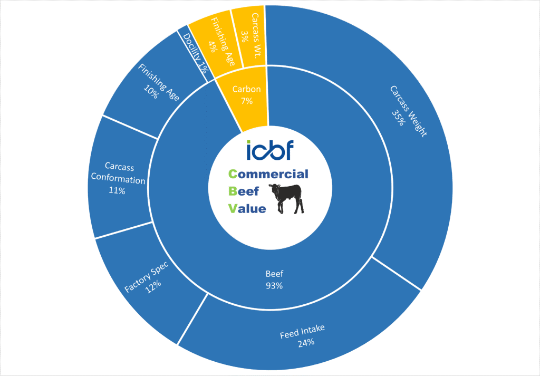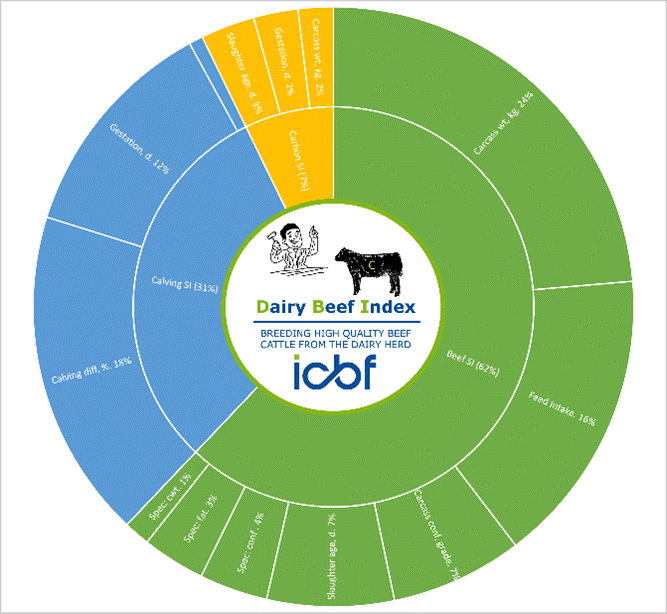Increasing the profitability of dairy-beef using the Commercial Beef Value (CBV)
In recent years, there has been a notable increase in dairy-beef cattle in Ireland. Historically, beef farmers lacked important information regarding the ‘genetic quality’ of dairy-bred cattle. However, the introduction of the Commercial Beef Value (CBV) has addressed this gap. This decision support tool has the potential to instigate tangible transformations within the industry, if beef farmers leverage this information in their procurement of cattle and if breeders of such animals respond to industry demands.
Increasing the profitability of dairy-beef systems using the Commercial Beef Value (CBV)
What is the CBV?
- The CBV, or Commercial Beef Value, is a tool for gauging the quality and anticipated profitability of non-breeding animals.
- The CBV offers farmers valuable insights into the genetic worth of their animals, encompassing traits important only for non-breeding (drystock) enterprises, such as carcass weight, conformation, finishing age and feed intake (Figure 1).
- CBV is denoted as a €uro value. A higher euro value signifies superior genetic merit across the included traits.
Figure 1. Commercial Beef Value
How does it benefit farmers?
- The CBV allows farmers to make more informed decisions when purchasing animals, regardless of age.
- Genotyped animals being traded through marts will have their CBV displayed on mart boards. When engaging in farm-to-farm sales, purchasers should request the CBV profile from the seller.
- The beef merit of calves can vary significantly even within the same breed (Table 1).
2023 Born Beef Calves from the Dairy Herd
| Sire Breed | BTM 10% | BTM 1/3 | Average | Top 1/3 | Top 10% |
|---|---|---|---|---|---|
| Angus | <€43 | <€63 | €72 | >€84 | >€116 |
| Aubrac | <€102 | <€122 | €132 | >€145 | >€179 |
| Belgian Blue | <€106 | <€141 | €160 | >€174 | >€208 |
| Charolais | <€126 | <€153 | €167 | >€184 | >€218 |
| Friesian | <-€25 | <-€3 | €6 | >€15 | >€36 |
| Hereford | <€29 | <€51 | €61 | >€75 | >€107 |
| Limousin | <€125 | <€148 | €159 | >€175 | >€209 |
| Simmental | <€59 | <€89 | €97 | >€116 | >€150 |
Table 1. CBV Values by breed for 2023 born dairy-beef calves, sourced from www.icbf.com
Teagasc Grange Research Herd Performance
Over multiple years at Teagasc Grange, within a grass-based system, high CBV genetics have consistently been more profitable, due to improved carcass traits at younger finishing ages and from lower concentrate input than low CBV beef x dairy and dairy x dairy steers (Table 2).
|
High Angus (€95 CBV) |
Low Angus (€61 CBV) |
Holstein Friesian (-€1 CBV) |
|
|---|---|---|---|
| Finishing Age (Months) | 21.1 | 21.5 | 23.6 |
| Carcass Weight (kg) | 314 | 306 | 311 |
| Carcass Conformation | O=/O+ | O= | P+/O- |
| Carcass Fat | 3+/4- | 3+ | 3+ |
| Finishing Period (days) | 51 | 62 | 127 |
| Finishing Supplement (kg) | 248 | 306 | 628 |
| Net profit per head (€) | 459 | 382 | 269 |
| GHG per kg carcass (kg CO2e) | 12.8 | 13.0 | 15.4 |
Table 2. Performance of 2020 and 2021 born dairy-beef steers of contrasting CBV managed within a grass-based finishing system.
National Herd Performance
Nationally dairy-beef cattle of higher CBV exhibit superior carcass weight, better conformation, and increased carcass value due to their increased ability to meet overall market specification, specifications compared to those of lower CBV (Table 3). Despite large differences in beef production efficiency (carcass value and finishing age), little difference in calf purchase price exists between the bottom and top 10% for dairy (€43) and Angus x dairy (€58) sired steers. The CBV is relevant all through the animal’s life. Therefore, beef finishers purchasing animals as calves, weanlings or store cattle, can utilise the CBV tool to assess the quality and efficiency of the animal.
| CBV Rank | Calf Price | Finishing Price | Finishing Age |
|---|---|---|---|
| Top 10% | €99 | €1538 | 817 |
| 2 | €85 | €1471 | 823 |
| 3 | €79 | €1455 | 826 |
| 4 | €79 | €1439 | 826 |
| 5 | €78 | €1415 | 824 |
| 6 | €71 | €1409 | 826 |
| 7 | €72 | €1392 | 827 |
| 8 | €67 | €1373 | 829 |
| 9 | €65 | €1338 | 832 |
| Bottom 10% | €56 | €1263 | 833 |
| Difference between top and bottom 10% | €43 | €275 | -16 |
Table 3. Calf Price, Finishing Price and Finishing Age for Dairy x Dairy Steers in 2023 by CBV Value
| CBV Rank | Calf Price | Finishing Price | Finishing Age |
|---|---|---|---|
| Top 10% | €249 | €1763 | 778 |
| 2 | €235 | €1689 | 787 |
| 3 | €230 | €1684 | 789 |
| 4 | €231 | €1653 | 790 |
| 5 | €229 | €1632 | 788 |
| 6 | €223 | €1608 | 792 |
| 7 | €218 | €1589 | 802 |
| 8 | €211 | €1569 | 805 |
| 9 | €208 | €1541 | 817 |
| Bottom 10% | €191 | €1490 | 831 |
| Difference between top and bottom 10% | €58 | €273 | -53 |
Table 4. Calf Price, Finishing Price for Angus x dairy steers in 2023 by CBV Value
How to breed calves of high CBV
- The Dairy Beef Index (DBI) is a genetic index used in dairy farming to select bulls that will produce calves suitable for beef production, while also maintaining desirable calving traits in their progeny.
- The index consists of three sub-indices: Calving, Beef and Carbon (Figure 2).
- Dairy farmers should select bulls with high beef sub-index values in the DBI in order to improve calf quality.
- The beef merit traits will be reflected in the CBV of the progeny.

Figure 2. Dairy Beef Index
